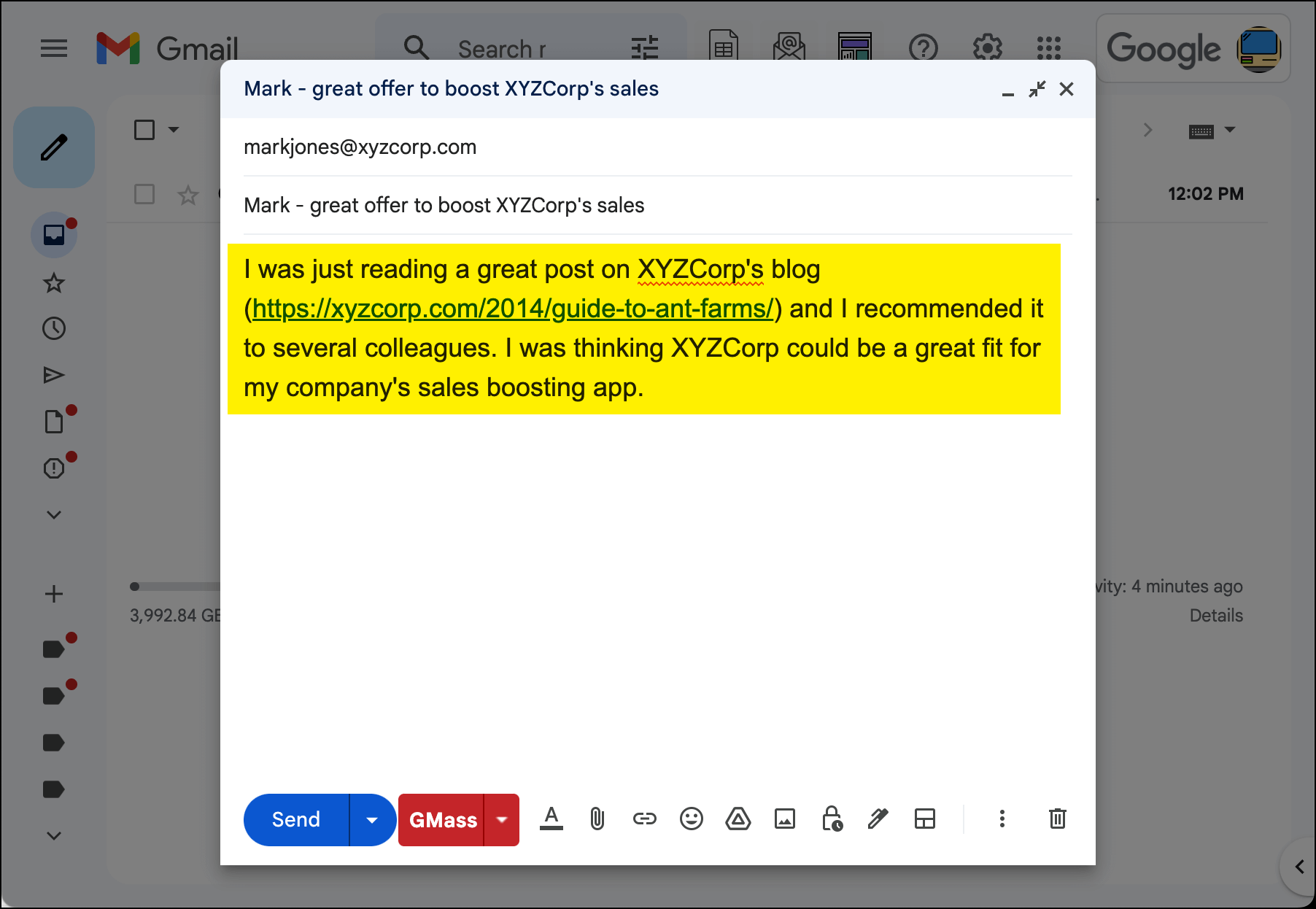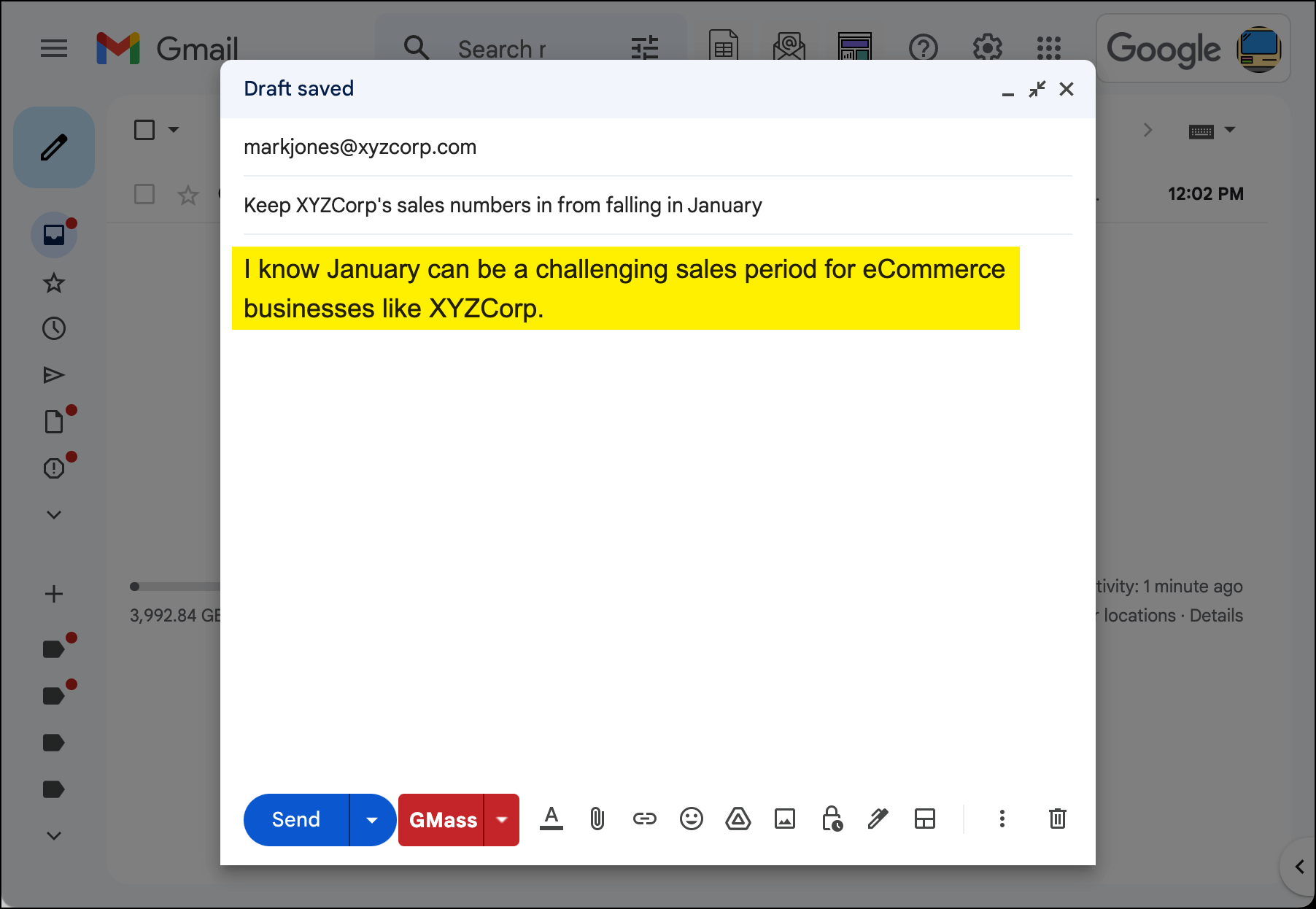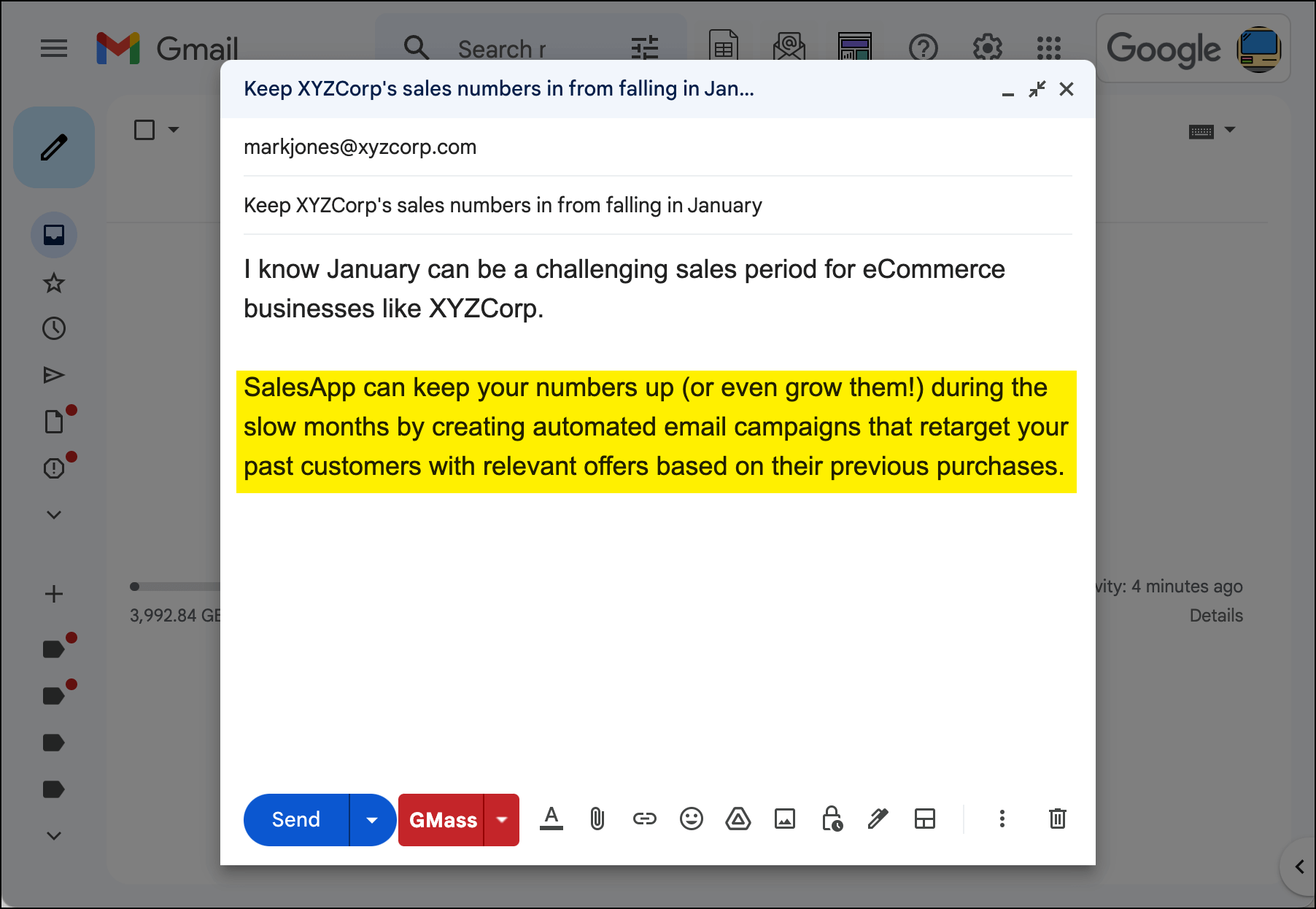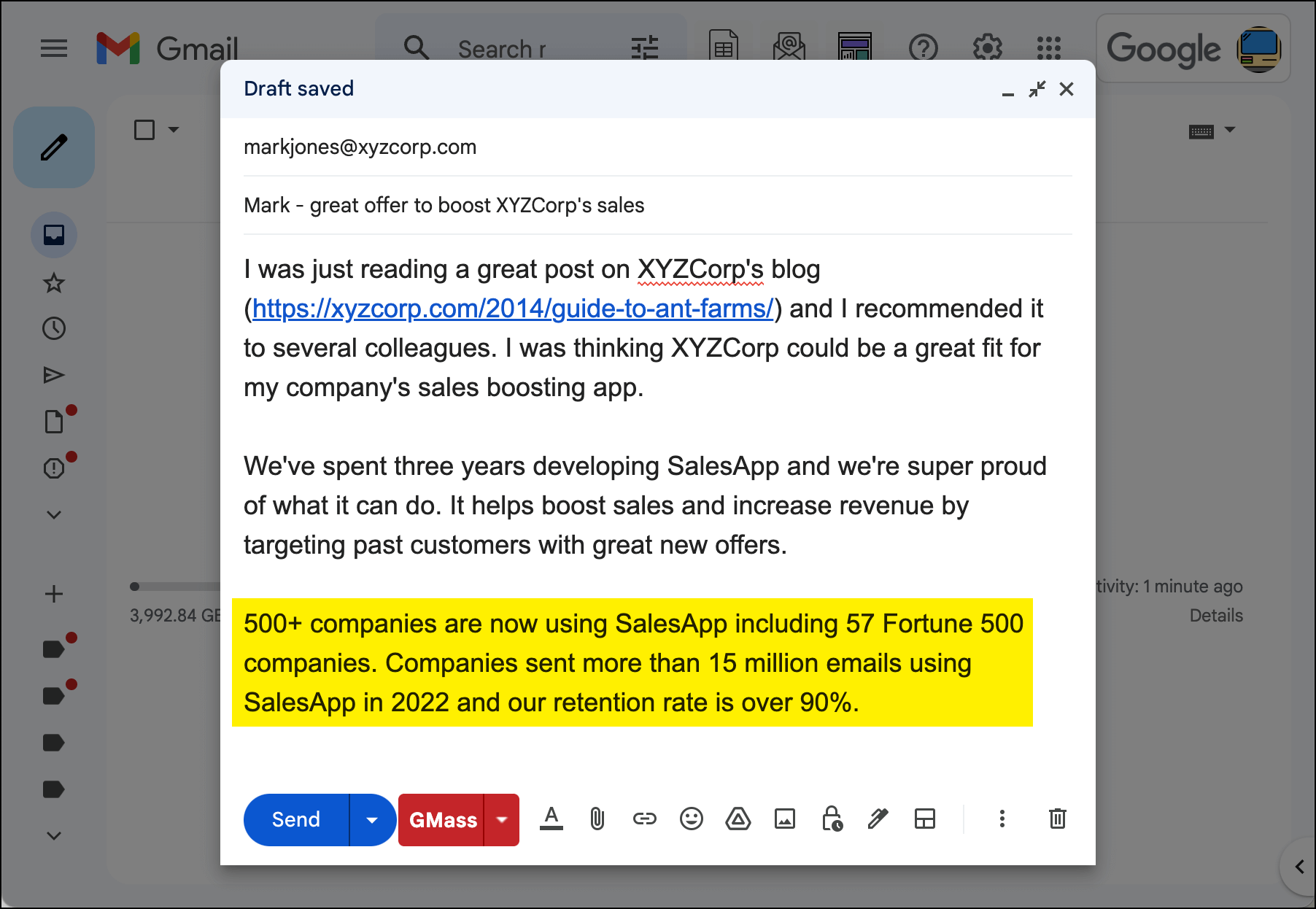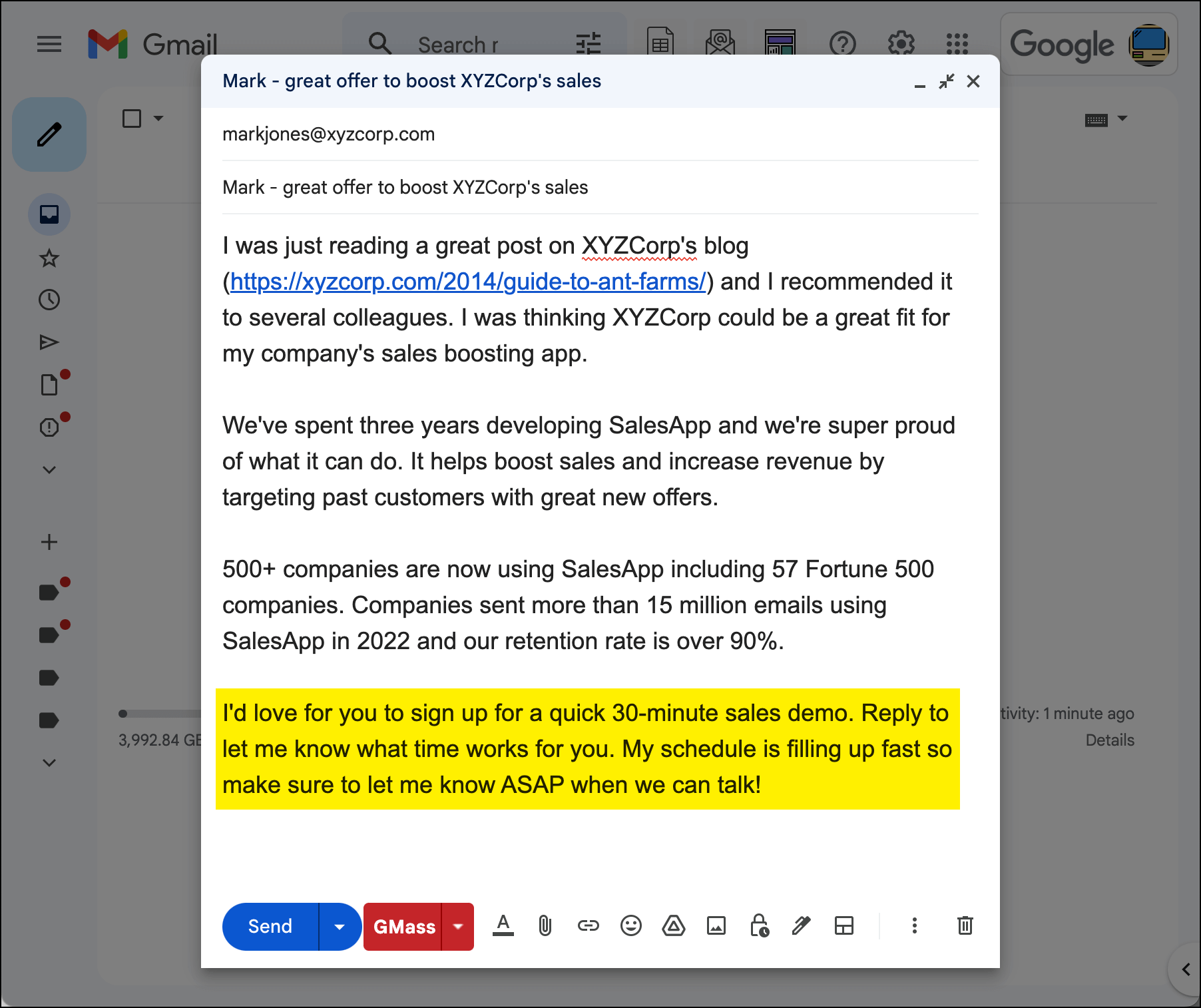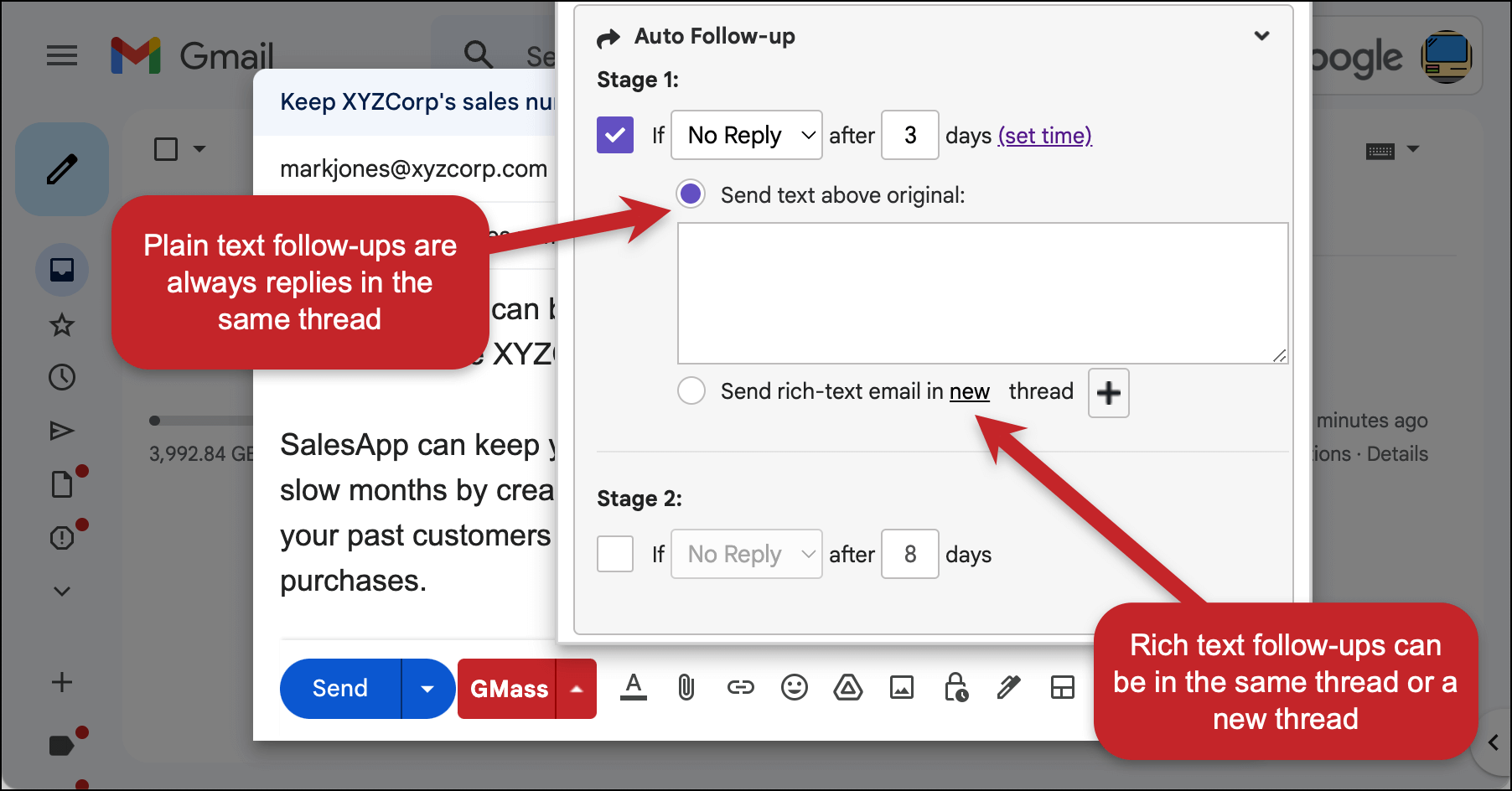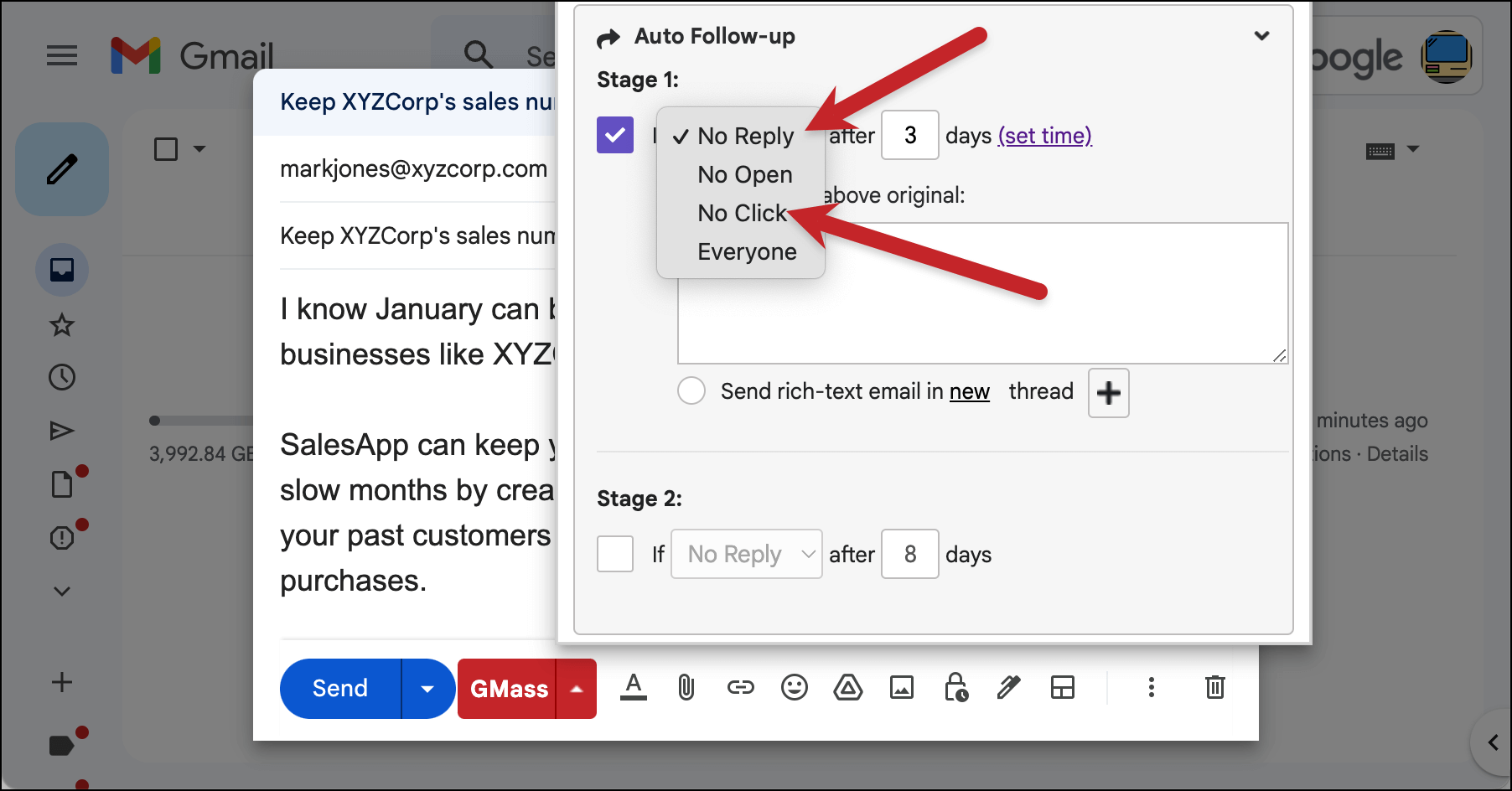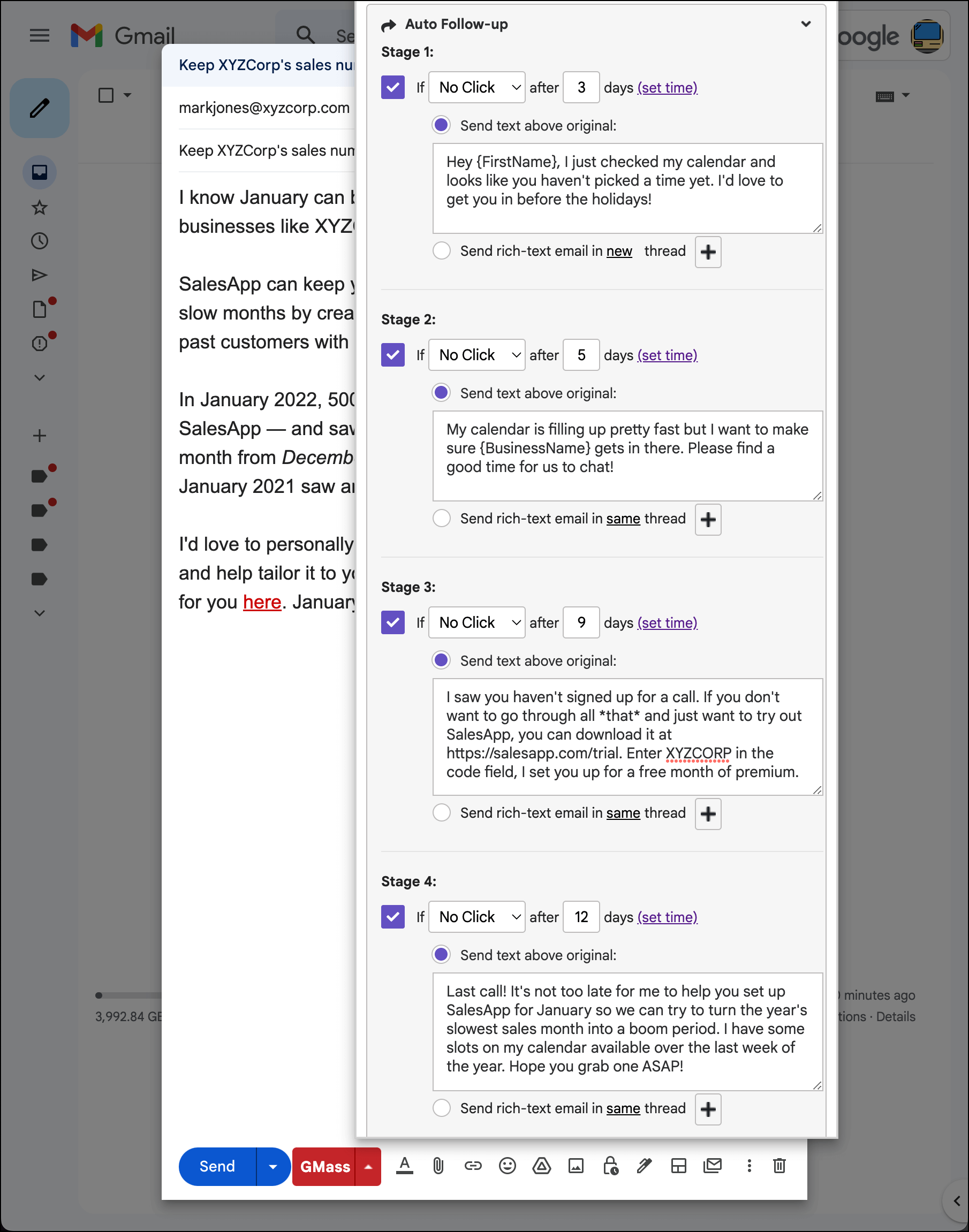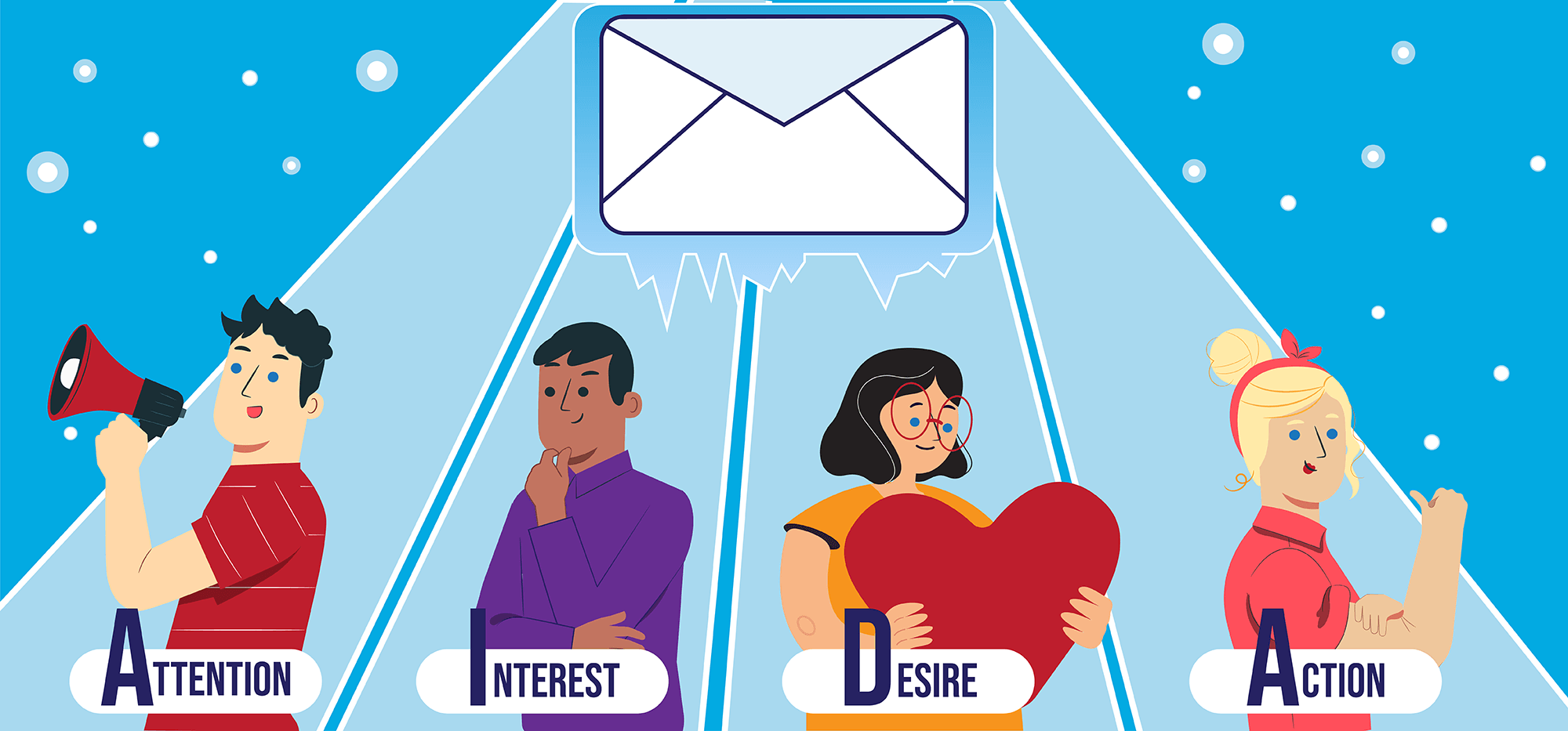
The AIDA formula is a classic sales and marketing copywriting method. And, when it’s done right, it can move someone from a cold prospect to a customer ready to make a purchase… in a mere four sentences.
In this article, we’ll cover strategies and best practices to use the Attention-Interest-Desire-Action model for cold email.
And throughout the article we’ll share examples of the cold email AIDA model in action.
Oh, and if you’re here because you were looking for info on the Giuseppe Verdi opera called Aida and/or the Elton John Broadway adaptation… maybe you can use these templates to convince a wealthy stranger to buy you tickets next time one of those comes through town?
AIDA Formula: Table of Contents
- What Does AIDA Stand For?
- 1. Grab a prospect’s attention with personalization
- 2. Build interest by showing your prospect how you’re going to solve their problem
- 3. Build desire by with social proof/results that are relevant to your prospect
- 4. Use urgency, scarcity, and an easy next step to spur action
- 5. Send automated follow-ups that continue the “action” section
- AIDA Formula: Takeaways and Next Steps
What Does AIDA Stand For?
AIDA stands for Attention-Interest-Desire-Action. It’s a popular and effective copywriting formula for nurturing a cold prospect into a warm lead.
The AIDA copywriting formula is based on the traditional sales funnel.
The four-step process is:
- Capture the prospect’s attention to stand out from all the noise.
- Build their interest in what you’re offering.
- Increase their desire by making your offer too good to resist.
- And compel them to take immediate action.
Here are the five keys to maximizing each portion of AIDA — as well as the follow-ups you send next.
1. Grab a prospect’s attention with personalization
There are two places in a cold email where you need to grab your prospect’s attention:
- Subject line (and possibly preview text, if you use it)
- Opening line of your email
Personalization is key — it’s a lot harder for a generic subject and opening to catch someone’s eye. But not all personalization carries equal weight.
The ideal form of personalization is correctly recognizing your prospect’s specific need or problem.
That’s far more important than showing off the data you’ve collected on the prospect.
You can blend in your prospecting data in that process — but identifying a problem outweighs reciting facts.
For instance, compare these two attempts to get someone’s attention in a cold email:
versus…
I’ve received hundreds of versions of that first example, and I never respond. There’s a fundamental flaw in the approach.
They’re mistaking data recitation and (obviously false) flattery for relevant personalization.
This is also the problem into which most AI cold email line writers fall. Those use AI to cyberstalk (err… cyber respectfully investigate) contacts. But they personalize with biographical details, which isn’t the same as identifying a problem or need.
The second subject/opening pair features way less customer dossier info… but is way more relevant. It shows an understanding of the business’s big problem and addresses them head-on.
The next line of this email will then demonstrate how the cold emailer’s offer can fix the prospect’s January sales problem.
(And hey, if you gauged the situation wrong and January isn’t a bad sales period for the business, they probably wouldn’t be a good fit for your offer anyway.)
What if your attention-grabbing offer isn’t a solution to a problem?
Not every cold email focuses on solving a prospect’s problem.
Link building emails, for instance, don’t really solve a prospect’s pressing problem. (Even if you try to frame them as “this link I’m suggesting will be great for your readers” — no one’s buying that.)
Cold emails in academia asking for recommendations or to join a lab group are another situation where your need is far greater than the recipient’s.
In those cases, you’ll need to get more creative with capturing your subject’s attention. While these methods aren’t quite as powerful as identifying someone’s problem, they also carry weight:
A genuine mutual connection
For example, when you went to the same college or have a mutual friend/contact.
Real flattery
Don’t mention an old blog post and say how great it was. Show you actually read something the recipient is proud of (or listened to them on a podcast). Share the real value you got.
Humor, or a deep cut personal reference
Check out the recipient’s social media and call out something you find in a humorous or insightful way.
For example, here at GMass, we all put our most embarrassing pop culture love in our about us bios. Mine is Miss Congeniality 2: Armed and Fabulous. A freelance writer reached out to me asking if I was hiring and made a joke about that movie. I didn’t have a work opportunity for her at the time, but because the joke caught my attention I checked out her portfolio. It was strong. And I’ve since recommended her to a friend who runs content at another company. If she hadn’t included the joke in the email, I know I wouldn’t have remembered her to make that recommendation.
Offer something of value, like buying them a coffee
If your offer can’t solve a pressing problem, you could boost the offer with a gift. For instance, you could say you’ll use DoorDash to send them a coffee for a Zoom “coffee meeting” with you.
Ultimately, you need to find something to stand out in a sea of email and get a prospect’s attention. And yes, all these techniques take time (and/or money). But won’t that extra time be worth it when your reply rate goes from 0% to 30%, 50%, 70%, or even 100%?
2. Build interest by showing your prospect how you’re going to solve their problem
Now that you’ve got a prospect’s attention, it’s time to build their interest.
And the best way to do that is by offering a clear solution the problem you just presented.
Here are examples of the wrong way and right way to build interest.
In the example with the wrong approach, we’ll present our app but do so in a way that’s:
- Generic
- Not directly related to solving the problem
- And focused more on us than the prospect
Compare that to the better approach:
The second version shows exactly how your offer will solve the problem. There are no vagaries; the line “keep your numbers up (or even grow them!)” isn’t something people are used to seeing in emails.
Other ways to build interest in a cold email
Showing how you can solve a prospect’s problem is a fundamental part of building interest — but it’s not the only way.
Some other options include:
Referencing their competitor
If you have proof the prospect you’re targeting is losing out to a competitor — and you can help them beat that competitor — you’ll pique their interest.
Citing your success
While you may want to save your social proof/track record for the “desire” section of the email, you don’t have to.
It’s possible you offer a service where it’s hard to clearly differentiate in a single sentence. (For instance, it’s tough to explain in one sentence why your SEO agency is different than every other SEO agency.)
In those cases, your resume may be the best way to pique interest. If you’re selling SEO services to law firms, you could cite how many other law firms you’ve worked with this year and the results.
Laying out specific personalized details
Referencing this law firm SEO example again, you could build interest through research.
You could include a short bulleted list of where the firm you’re targeting ranks for important keywords — then share a few optimization ideas you’d use to improve.
What’s in it for them?
As I talked about earlier in the article, not every cold email is a mutually-beneficial sales email. In some cases, you’re making a bigger ask. In those situations, you can build interest by making it even clearer what’s in it for them.
3. Build desire by with social proof/results that are relevant to your prospect
The “D” in AIDA stands for desire… but I’ve also seen people refer to it as “decision.”
The intention is the same regardless of what the “D” stands for. Either way, the goal of this part of the cold email is to take someone who’s interested and push them over the top. By the end of the “D” section, the prospect should now want what you’re offering. (Or, at a minimum, want to learn more about it.)
This is the portion where you want your offer to seem too good to be true. Where you want the prospect to wonder where you’ve been all their life.
It’s the place where you can share your most compelling social proof, qualifications, and/or results.
But make sure whatever you share is relevant to your prospect. Here’s an example of the wrong way and right way to build desire in a cold email.
Here’s the wrong approach:
While those social proof stats are impressive, they’re not relevant to the problem nor the prospect. They’re just big numbers for big numbers’ sake; the sender is confusing impressive for relevant.
Here’s a better approach:
In this version, there’s still social proof (500+ others) but the rest of the numbers speak directly to the prospect’s problem.
A good cold email always keeps the focus on the recipient, not the sender. And that can be tough… especially in the portion of the email where you’re addressing “why you?”
But the more you tie your past success to a prospect’s potential future success, the better off you’ll be.
4. Use urgency, scarcity, and an easy next step to spur action
The end of your email is the “close” — everything else builds to this moment, where you want the prospect to take the next step.
That next step may be a reply, a click, a phone call, or an offline action.
We have three goals with the action section of the email:
- Create a sense of urgency and/or scarcity to drive immediate action
- Make a clear, simple request that doesn’t seem too difficult, costly, or time-consuming
- Stand out visually from the rest of the email.
Here are the emails we’ve been working on throughout this article with the wrong way and right way to approach the call-to-action.
The wrong way:
This goes wrong across the board:
- “Quick 30-minute sales demo” is an oxymoron. 30 minutes isn’t quick.
- “Sales demo” is a turn-off. Sounds like this prospect will be volunteering for a timeshare presentation without getting a free set of golf clubs at the end.
- The attempt to create urgency makes it sound like it’s going to take several back-and-forth emails to find a time that works.
- This call-to-action does not stand out visually.
Here’s a better approach:
This action section takes a different approach:
- I say “super quick walkthrough” rather than designating a specific time. After all, to some people “15 minutes” or “30 minutes” may not feel quick.
- A “sales demo” is something that serves the salesperson. A “walkthrough” to “tailor it to your exact needs” is something that serves the customer.
- “Grab any time” is casual and doesn’t sound like you’re giving the person work or an obligation.
- This email creates a sense of urgency by tying back to the customer’s issue: January sales numbers.
- “Here” is the only link in the email, so it stands out. And it’s eye-catching red.
5. Send automated follow-ups that continue the “action” section
It’s always smart to send automated follow-up messages to a cold email campaign. And with the AIDA format, you should view your follow-ups as continuations of the “action” section.
There are three keys to making that work.
Send your auto follow-ups as replies to the first email
Rather than sending your auto follow-ups as new email threads with new subject lines, send them as replies.
That simulates one-on-one email behavior, even when you’re sending at scale. It also gives your prospects an instant frame of reference back to your initial offer so you can avoid repeating everything in every message.
With GMass, you can choose to send your auto follow-ups as replies or as new messages in new threads. In most traditional AIDA cold email situations, replies make the most sense.
Keep your follow-ups going until you get your desired action (click/reply)
How long should your auto follow-up sequence continue? GMass offers a maximum of eight auto follow-ups (so a total of nine emails). Do you need that many? It’s up to you and your tolerance for nudging your prospects.
But regardless of how many follow-ups you send, you need to make sure those emails stop when you get your desired result. You can choose to continue to send follow-ups if there’s “No Click” or “No Reply” — pick the one relevant to your cold email.
(You can also send if there’s “No Open” or send all follow-ups regardless of action; those situations are usually less applicable to cold email.)
Try different approaches to push the prospect into taking action
What might be causing hesitation or keeping your prospects from taking action? And how can you remedy that?
You can use your follow-ups to push action by trying different techniques including:
- Urgency
- Scarcity
- Lowering the obligation/effort required
- Asking what the hesitation is
- Reiterating the value proposition
- Offering more social proof
For instance, here’s a follow-up sequence for our example email that tries four different calls-to-action:
Each of these tries a different approach to drive action:
- The first follow-up is a gentle reminder with an extra dose of urgency.
- The second follow-up creates a sense of scarcity but demonstrates personalized attention.
- The third follow-up hypothesizes that the recipient doesn’t want to bother with a call but might still want the product. So it lowers the “lift” by giving them a personalized offer to skip the call.
- And the fourth follow-up creates the ultimate sense of urgency while restating the value proposition.
I could keep going after this, adding more follow-ups and trying more tactics. And I could feel confident that after this AIDA email and follow-up sequence, if the person still hasn’t clicked, they’re definitively not interested.
AIDA Formula: Takeaways and Next Steps
The AIDA formula is a tested and proven method for moving cold email prospects through the sales funnel and motivating them to take action.
AIDA is an economical format — it keeps your cold emails short and focused, both of which are good things.
And with the strategies and examples I laid out in this article, you should begin to see how you can use the AIDA formula for your cold emails.
- For the first A, attention, hook your prospect with your subject line and the opening to your email by correctly identifying their specific problem or need. (Or, in lieu of that, make your subject and opening line so personalized they can’t resist.)
- For the I, interest, share the specific way you’re going to solve their problem. Even better: If you can differentiate yourself to make it clear you’re the only one with the perfect solution.
- For the D, desire, use relevant social proof and/or results to make it clear just what your prospect will be missing out on if they don’t take your offer.
- And for the second A, action, craft a call-to-action that creates a sense of urgency and/or scarcity — and that doesn’t feel like a huge, time-consuming or costly obligation.
Also make sure you set up an auto follow-up sequence where you continue to try different calls-to-action to get the prospect to click or reply.
GMass makes this whole process ridiculously easy… so please sit back and relax while I end this article by AIDA-ing GMass for you.
You’re trying to send cold emails but you keep running into the same killer issues: New, quirky software platforms to learn (and teach your staff)… poor deliverability… too many limitations… too expensive.
GMass solves all those problems…
- It works directly inside Gmail so there’s no new app to learn.
- 99% of users report the best deliverability they’ve ever had thanks to things like Spam Solver, and custom tracking domains.
- GMass has unlimited everything (emails, contacts, campaigns) and even helps you break Gmail’s daily limits.
- And somehow, it’s still the most cost-effective cold email platform on the market.
GMass has more than 300,000 passionate users who’ve given it an unheard-of 4.8-star average rating in the Chrome Web Store on 7,500+ reviews.
To get started, just download the extension for Chrome. There’s no credit card required for the free trial — and with our quickstart guide, you’ll be sending your first campaign in a matter of minutes.
Email marketing, cold email, and mail merge all in one tool — that works inside Gmail
TRY GMASS FOR FREE
Download Chrome extension - 30 second install!
No credit card required

